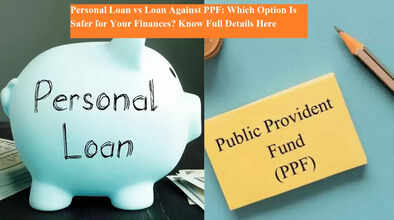Personal Loan vs Loan Against PPF: Which Option Is Safer for Your Finances? Know Full Details Here

When you suddenly need money—whether for a medical emergency, education, or a wedding—loans often become the go-to solution. But the question arises: should you choose a Personal Loan or a Loan Against PPF (Public Provident Fund)? Both options serve different financial needs, and each has its pros and cons. Let’s understand the difference between the two and find out which one suits your pocket better.
What Is a Loan Against PPF?
A Loan Against PPF is a secured loan, meaning your PPF account acts as collateral. This type of loan can be availed only if you already have an active PPF account that is at least three years old. You can borrow up to 25% of your PPF balance at the end of the second financial year immediately preceding the year of the loan application.
For instance, if your PPF balance is ₹4 lakh, you can get a maximum loan of ₹1 lakh. The interest rate on this loan is typically 1–2% higher than the prevailing PPF interest rate, which is currently around 7.1%. So, you’ll likely pay around 8–9% interest per annum. The repayment tenure is up to 36 months, making it suitable for those who need short-term funds at a lower cost.
Since it’s a secured loan, the risk for the lender is minimal, and you don’t need to provide any additional documentation or credit score proof. However, the loan amount is limited, and it’s ideal only for those who need a small sum of money.
What Is a Personal Loan?
A Personal Loan, on the other hand, is an unsecured loan—you don’t need to pledge any asset or savings account. The approval depends mainly on your income, credit history, and repayment capacity.
The interest rates on personal loans generally start from 9.99% and can go up to 18–24%, depending on the bank and your credit profile. The loan amount can range from ₹50,000 to ₹25 lakh or even more, depending on your eligibility. The repayment tenure is flexible — usually between 12 and 60 months.
Because it doesn’t require collateral, the processing is fast, often completely online, and you can get instant approval and disbursal in many cases. However, the higher interest rate means you’ll end up paying more in total interest compared to a PPF-backed loan.
Key Differences Between the Two
| Aspect | Loan Against PPF | Personal Loan |
|---|---|---|
| Type | Secured (PPF as collateral) | Unsecured |
| Loan Amount | Up to 25% of PPF balance | Based on credit score and income |
| Interest Rate | Around 8–9% | Starts at 9.99% and can go higher |
| Repayment Tenure | Up to 36 months | 12–60 months |
| Documentation | Minimal | Requires income proof and credit check |
| Processing Time | Moderate | Fast and often online |
| Risk to Lender | Low | High |
| Ideal For | Small, short-term needs | Larger financial requirements |
Risks and Considerations
While both loans can help you during a financial crunch, they come with certain risks.
-
Higher Interest Burden: Personal loans, due to their higher rates, can significantly increase your repayment cost.
-
Credit Score Impact: Missing EMIs on a personal loan can damage your credit score, making it harder to borrow in the future.
-
Debt Trap Risk: Over-borrowing through personal loans can lead to long-term financial and mental stress.
-
Limited Availability: PPF loans, though cheaper, are limited in amount and available only to existing PPF holders with sufficient balance.
Which One Should You Choose?
If you already have a PPF account and need a small amount for a short duration, the Loan Against PPF is a safer and cheaper option. It keeps your credit score unaffected and offers lower interest rates.
However, if you need a larger sum urgently and can manage timely repayments, a Personal Loan is more practical. It offers quick disbursal, flexible tenure, and no need for collateral.
In short, choose a Loan Against PPF for low-cost, short-term needs, and opt for a Personal Loan when you need higher funds quickly. Understanding your financial capability and repayment capacity is the key to choosing the right one.

